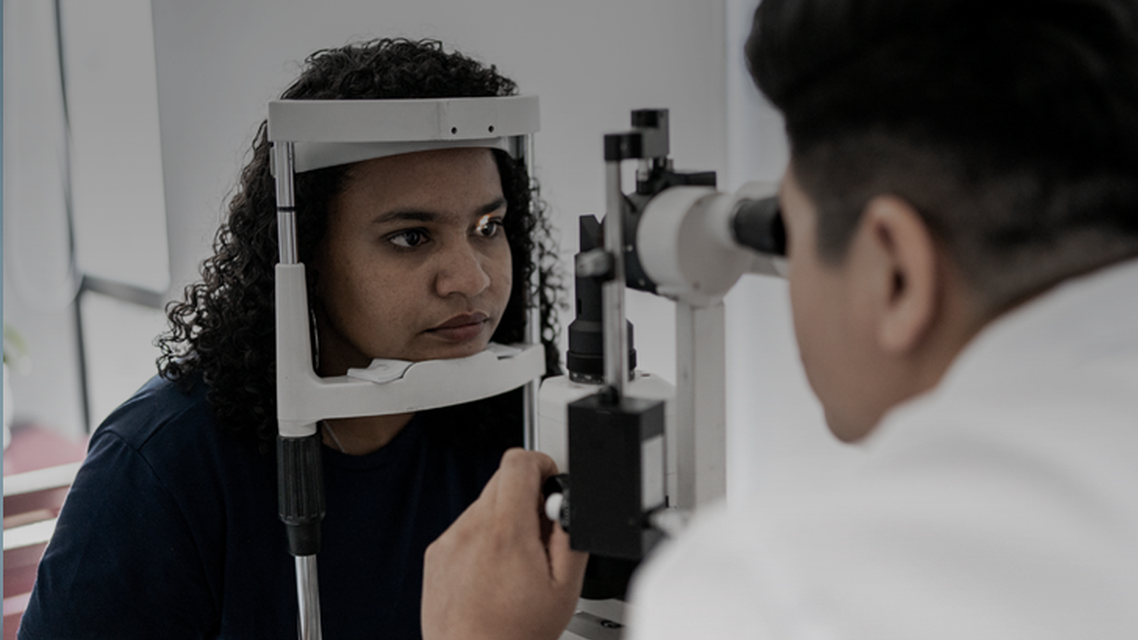Announcer:
Welcome to CME on ReachMD. This activity, titled “Strategies to Reduce Treatment Burden for Vulnerable Patients with Diabetic Eye Disease,” is provided by Prova Education.
Prior to beginning the activity, please be sure to review the faculty and commercial support disclosure statements as well as the learning objectives.
Dr. Vega:
Diabetic macular edema is a treatable condition; yet, gaps exist in vision outcomes for minority patients and patients of low socioeconomic status. How can new and emerging treatment modalities be used to close these gaps?
This is CME on ReachMD, and I'm Dr. Chuck Vega. I'm very happy to be joined today by Dr. Pradeep Prasad. Welcome to the program.
Dr. Prasad:
Thanks for having me.
Dr. Vega:
First of all, I want to say, Pradeep, that I am immensely grateful to the field of ophthalmology, because no specialty, none, really takes more care when I call with the red flag symptoms: sudden vision loss, a painful globe. I know that you really try in ophthalmology to fit those patients into your clinic schedule, which avoids patients going to the emergency department and waiting a long time to get that right care. So I really appreciate it.
At the same time, when that happens, it also pains me because I know that a lot of those ocular emergencies could have been prevented in the first place with regular maintenance of care and good preventive measures. So in your view, how can we do a better job in reducing patients’ risk of severe vision loss or other negative outcomes associated with ophthalmologic emergencies?
Dr. Prasad:
Absolutely. It's a great question. And I think there's really 3 approaches that I would recommend. One is we have to have good collaboration with our colleagues in primary care and endocrinology. So much of what we can achieve in the eye is based on how our patients’ overall cardiovascular and metabolic health is optimized. And we know from a number of landmark studies that optimization of glycemic control, blood pressure, and lipids, as well as addressing other cardiovascular risk factors like smoking, anemia, these are all factors that can help to decrease risk of both onset of diabetic retinopathy and for those who already have diabetic retinopathy, decreasing the risk of progression.
But there is a couple of other factors that we should also consider. One is, how do we get patients into our clinic, and how do we keep them there? So in terms of getting patients into our clinic, we have to be creative and utilizing technology to try to screen patients, because there is limited capacity in our clinics to see every diabetic patient. We want to use technology in a way that can help us to screen those patients who really need to come in for a diabetic eye exam.
And then finally, in terms of keeping patients in the clinic, you know, this is a working-age patient population. And so we need to recognize the fact that it may be difficult for patients to come in or they may need to cancel appointments because of other responsibilities, work-related responsibilities. So to the extent that we can make it easier for patients to get in and also to reschedule their appointments, it can also help to increase compliance and hopefully identify opportunities to prevent diabetic eye disease down the road.
Dr. Vega:
Yeah, I love those points. When we think a lot about cardiorenal metabolic care of patients with type 2 diabetes, and type 1 diabetes these days as well, where we’re really putting it all together as opposed to just treating diabetes, that's good for the heart. And it's good for the eyes as well, so it's something we really should be embracing. And I really like the concept of using teleophthalmology too, or using technology and leveraging that, because so many individuals are not up to date with their screening. And so those folks can be with – fundal photographs can really be a game changer for advancing their care overall.
In my clinic, 80% of my patients prefer Spanish, so Latinos are a very important population for me, but they also have some of the highest rates of diabetes and diabetic eye disease among major racial and ethnic groups in the United States.
What have you found with your research when we think about Latinos or Hispanics and diabetic eye disease specifically?
Dr. Prasad:
You're absolutely right. We do see higher disease burdens in the Latino community. We certainly see that in the Department of Health Services where the vast majority of our patients are Latino. There may be a number of factors that play into that, one of which may be genetic.
We did a study actually looking at our diabetic retinopathy screening program. And specifically, we were looking at a subset of patients who are the young-onset type 2 diabetics. You know, diabetes is an epidemic, and we're seeing it earlier, earlier, and earlier in our patient population. And what we were hoping to understand is how this patient, that young-onset type 2 diabetic patient population, might be a little different than the others. And what we found, particularly in the Latino community in this study, was that they were at a higher risk for developing both ocular and non-ocular complications of diabetes. So they were at higher risk for vision loss, higher risk for needing therapeutic intervention, including surgery, but were also at higher risk for other diseases like chronic kidney disease and diabetic limb disease.
So there again, I think that the factors that play into what specifically puts the Latino community perhaps at a higher risk for complications of diabetes is still being elucidated. We certainly have to recognize that this is an at-risk population and we need to do more to try to serve that in that community.
Dr. Vega:
For those of you who might just be tuning in, you’re listening to CME on ReachMD. I’m Dr. Chuck Vega, and here with me today is Dr. Pradeep Prasad. We’re taking a look at new treatment options for diabetic eye disease and ways they can be used to optimize vision outcomes in vulnerable patient populations.
So, Pradeep, we know that it’s hard for our patients to make it to all of their appointments. And that's particularly true if they have lots of family responsibilities, lots of job responsibilities, and particularly when they're low income. All those factors can make patients miss appointments and lead to negative outcomes, like we discussed. What about the role for durable treatments? Particularly for patients like those that you're seeing, it seems like that would be a big benefit.
Dr. Prasad:
Absolutely. You know, we are really blessed to have so many therapeutic options at our disposal now. When anti-VEGF [vascular endothelial growth factor] therapy, which is really the mainstay of treatment for a disease like diabetic macular edema, was first introduced, patients were receiving injections on a monthly basis. And while many of them had excellent outcomes, receiving injections on a monthly basis can be particularly onerous and burdensome for patients. On average, patients can receive up to 6 or 9 injections in the first year alone.
Now we have therapeutic options that allow us to increase the interval between our treatments. So instead of receiving injections on a monthly basis, some of our patients may be able to get to a point where they're receiving injections perhaps every 12 or even up to every 16 weeks. Some of these medications will include drugs like faricimab. Faricimab is an interesting drug. And, you know, it actually targets both VEGF, which we're familiar with with the other anti-VEGF pharmacologic agents, but there's an arm to this medication that also targets Ang-2. And Ang-2, we think that the antibody to Ang-2 actually helps to increase vascular stability, so decreases permeability, and may be an alternate pathway whereby we can fight against the swelling that we see in diabetic macular edema. There's an inflammatory component to diabetic macular edema that also may be suppressed by targeting the Ang-2 pathway.
I do have some patients where I've been able to have a good therapeutic response with aflibercept. But I haven't been able to extend the interval between their treatment. And so this is an area where faricimab actually has been hugely beneficial to me.
So this is a patient, for example – let me show you a picture here of a patient. This is a 56-year-old female, and she was receiving initially monthly injections of aflibercept. And you see the cystoid macular edema on her OCT [optical coherence tomography] has improved after monthly injections. But she has a recurrence. And you can look at this image, approximately 2 months after her last injection, and we see a recurrence of the edema. So we get that edema back under control, as you can see here, after another monthly injection of aflibercept. And what we're trying to do is to try to increase the interval between these injections, but I'm just not able to go any longer than 8 weeks between her injections. Now every 8 weeks is better than every 4, but the patient's really having a hard time coming in every 2 months for an injection.
So we decided to try faricimab as an option. And this patient actually has a history of glaucoma, also has a natural lens. So some of the other options, for example, steroid options where the side effects would include elevated intraocular pressure or exacerbation of a cataract, that wouldn't be a great option for this patient. But you can see here with the injection of faricimab, this next picture is 10 weeks, and then I'll show you another picture at 12 weeks after injection, and then you see that we have maintenance of the thickness in the central part of the macula. And her vision has maintained as well.
So now we've gone 3 months between her injections and been able to achieve the same outcome that we were able to achieve with aflibercept every 8 weeks. And that may not seem like a big difference. But when we're talking about 6 visits to the ophthalmologist’s office per year, versus 4 visits, that can actually make a huge difference in a patient and family members’ life.
And then when you start thinking about other medication classes, like steroid medications, we can even further increase those intervals for every 3 months, perhaps to every 6 to perhaps even every year.
And then the final category that I think is worth mentioning are implantable devices. So there is a port delivery system, which is surgically implanted that actually holds anti-VEGF medication. That medication is eluted into the eye over a long period of time. And those patients need refills of that surgically implanted device, but it can be done every 6 months.
So again, we're getting to a point where we have many therapeutic options and certainly therapeutic options now that can decrease the number of visits that patients are having on an annual basis, increasing potentially their compliance, and hopefully that results in better visual outcomes.
Dr. Vega:
So are you using those more durable treatments specifically for folks with more barriers to coming into the office?
Dr. Prasad:
I am. And there's a number of factors that play into what kinds of medications I can use, but certainly, we start out typically with monthly injections. Even for those medications that allow us to go to every 12 to every 16 weeks between treatments, we're usually still starting on a monthly basis but then extending those intervals as we see the patient's therapeutic response.
Dr. Vega:
So it's certainly an exciting time. And thank you for elucidating, you know, some of those newer treatments in diabetic eye care.
Before we conclude today, Pradeep, I want to give you the floor for any take-home messages you have for our audience.
Dr. Prasad:
I think that the most important thing to keep in mind is that diabetic eye disease really requires a multipronged approach. We certainly have a lot of therapeutic options in ophthalmology, but when thinking beyond ophthalmology, we also have to make sure that we're working together as a team. You mentioned earlier that you're very appreciative of us in the ophthalmology community. Well, I have to say I'm very much appreciative of the primary care physicians and endocrinologists that collaborate with me, and I'm always so appreciative that they're able to do their best to keep my patients healthy. That really makes my job a whole lot easier.
Dr. Vega:
Yeah, so it's a mutual admiration society at the end of the day, but it is centered on patients, and I really do see better outcomes. You know, from my side, it's about making those referrals, asking, and hopefully having some really systematic way that we are tracking patients and their eye screening in cases of diabetes, because too many patients don't make it in on time for screening, and that's, I think, where bad outcomes are seeded, unfortunately.
And folks with more barriers to care, we really need to do some extra outreach with them to understand why they're experiencing some barriers and then try to strategize with them the means to overcome those barriers.
Overall, Pradeep, this was a wonderful conversation. Thank you very much for participating today.
Dr. Prasad:
Well, thanks so much for having me.
Announcer:
You have been listening to CME on ReachMD. This activity is provided by Prova Education.
To receive your free CME credit, or to download this activity, go to ReachMD.com/Prova. Thank you for listening.

















Facebook Comments